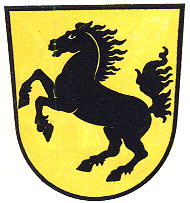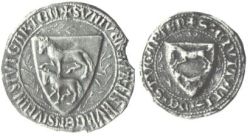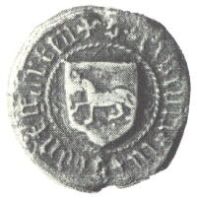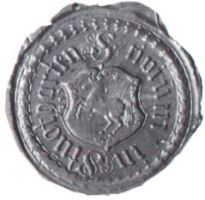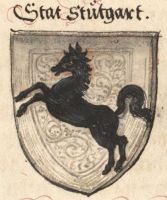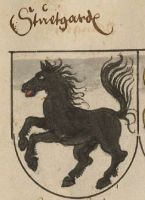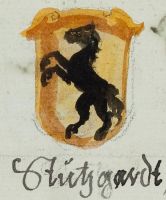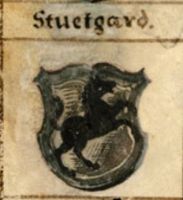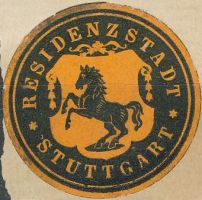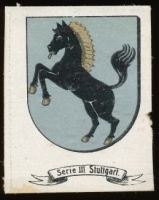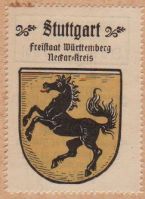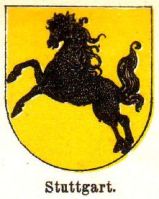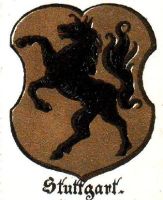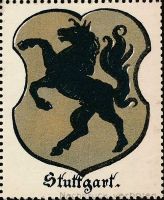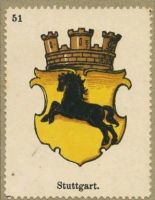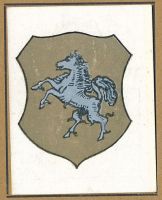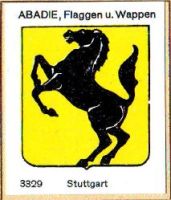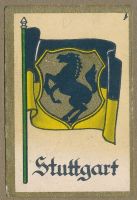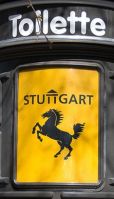Stuttgart
|
Country : Germany State : Baden-Württemberg District (Kreis) : Urban district (Stadtkreis)
|
| German | blazon wanted |
| English | blazon wanted |
Origin/meaning
Stuttgart became a city in the 13th century and the capital of the Counts of Württemberg in 1312. From the same year the first seal is known. It shows 2 running horses. The two horses also appear in the two next seals, the lower horse being smaller than the upper one. It has been mentioned that the arms thus showed a horse and a foal, but it is more likely due to the shape of the shield that the lower horse is smaller.
The first seal with a single horse dates from 1433 and is so small, that there simply was no room for two horses. It is the first seal that shows only a single horse. All later seals until the end of the 18th century show a single horse.
In the end of the 15th century a lady appears as a supporter behind the shield. The lady still appears in a seal from the end of the 17th century, but disappears in later seals. Similarly, in some seals appears a small star, but this star also disappears in the late 18th century.
In a seal from 1642 the horse is first shown rampant, instead of running. Ever since the horse has been shown this way.
A second horse appears again between the +/- 1720 and 1820. This time it clearly shown as a foal. This practice was also discontinued in the 1830s. Ever since the arms have not changed.
The horse itself is a canting symbol. Stute = female horse, and the name is supposed to have been Stutengarten, or garden of horses. Duke Ludolf of Schwaben founded, according to legends, in 950 a horse breeding center and riding school on the spot of the present city.
The colour of the horse is known as black since 1490. The field historically was silver, but started to change to gold since 1618 and 1854 to have the same colours as the arms of Württemberg. In between, silver and golden fields are used both.
Furthermore, there are many variations of the arms known. First, the horse is sometimes shown facing left, instead or right. This was only seen in images, never on seals. The colours were shown in 1599 as red on a unrecognisable dark field. The actual shape of the horse varies widely, according to the style of the painter or sculptor. The arms were for the first time officially described in 1885 in the present colours and shape. The additions of smaller municipalities has not changed the arms.
Image gallery
The arms in a 16th century manuscript
The arms in a German album +/- 1910
The arms by Hupp in the Kaffee Hag albums +/- 1925
The arms in an album from around 1910
The arms in the Wappen-Sammlung (+/- 1910)
The arms in an album from 1930s
The arms in the Abadie albums
The arms in an album, 1950s
The arms in an album from 1952
The arms on a matchbox label
The arms in an album from 1968
Literature: Stadler, K., 1964-1971; Bardua, 1973.
This page is part of the German heraldry portal Deutsche Wappensammlung |
Heraldry of the World |
|
German heraldry:
|
Selected collector's items from Germany:
|
Contact and Support
Partners:
Your logo here ?
Contact us
© 1995-2025, Heraldry of the World, Ralf Hartemink 
Index of the site
